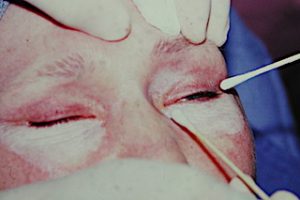Contrary to the perception of many, upper and lower eyelid (blepharoplasty) surgery will not do much to improve wrinkles around the eyes. Eyelid procedures are for removing redundant skin and herniated fat. For wrinkle improvement around the eyes, chemical peels are one good option for wrinkle reduction.
If chemical peeling is to be done at the same time as a lower eyelid procedure, it can only be done if the lower eyelid technique is transconjunctival. (meaning no formal skin-muscle flap is raised) If a more formal blepharoplasty is being done, one should wait at least 3 months after before doing so. The combination of the two together will likely result in scarring and ectropion. (pulling down of the lower eyelid)
Chemical peeling is not usually done on patients with any significant skin pigment. This would eliminate many ethnic groups such as most African-Americans, Asians, and Hispanics. There is a real risk of losing some color (pigment) and the risk simply isn’t worth it.

The use of medium-depth peels are usually done in two layers, applying two superficial wounding agents. In my Indianapolis plastic surgery practice, I use a first layer of a Jessner’s solution, a keratolytic agent, before putting on a 35% trichloroacetic acid solution. This enhances penetration and the overall result while retaining a good margin of safety. The peel will develop an immediate frost which is then covered with antibiotic ointment. It can be performed under topical anesthesia in the office.
Deeper eyelid peels are most commonly done with a phenol solution. While full face phenol peels have largely faded since laser resurfacing became popular, they are still a good technique in the lower eyelid when significant wrinkles are present. Concentrations of either 50% or 88% are used which causes injury to the medium depth of the skin thickness. The phenol peel produces the greatest change in skin pigment and wrinkle reduction while also producing some skin tightening. Phenol lower eyelid peels should be done in the operating room because they cause more pain and any tearing into the peel will cause it to penetrate deeper and create a full-thickness burn.
Lower eyelid chemical peels can be done simultaneously with a transconjunctival lower blepharoplasty, as a delayed treatment for wrinkles three months after, or as stand alone chemical peel when blepharoplasty is not needed.
Dr. Barry Eppley
Indianapolis Indiana


